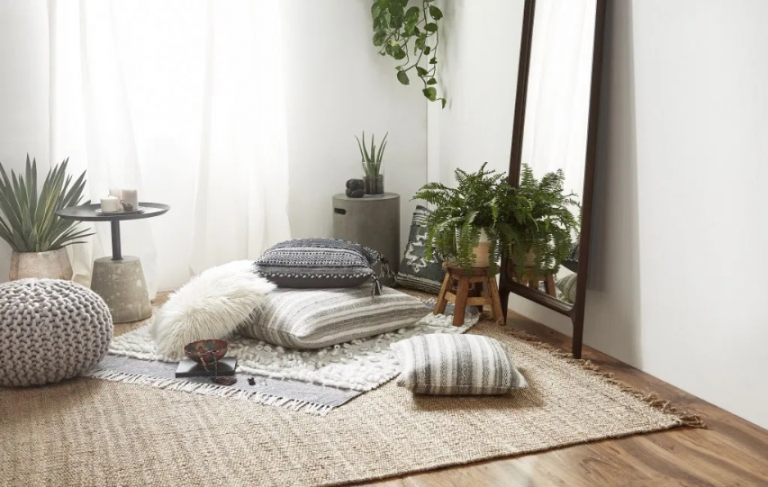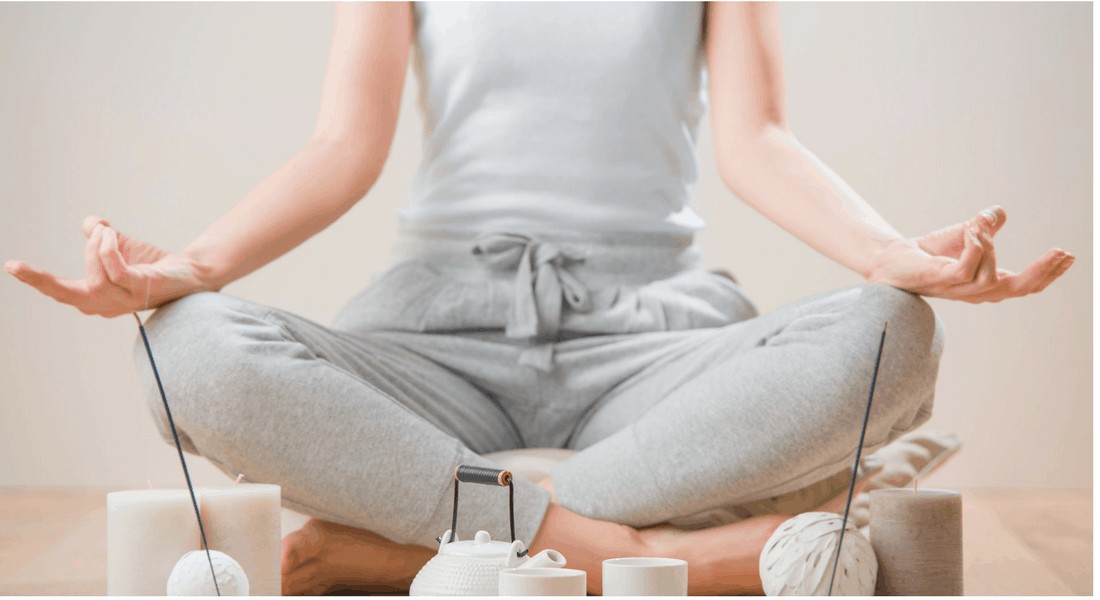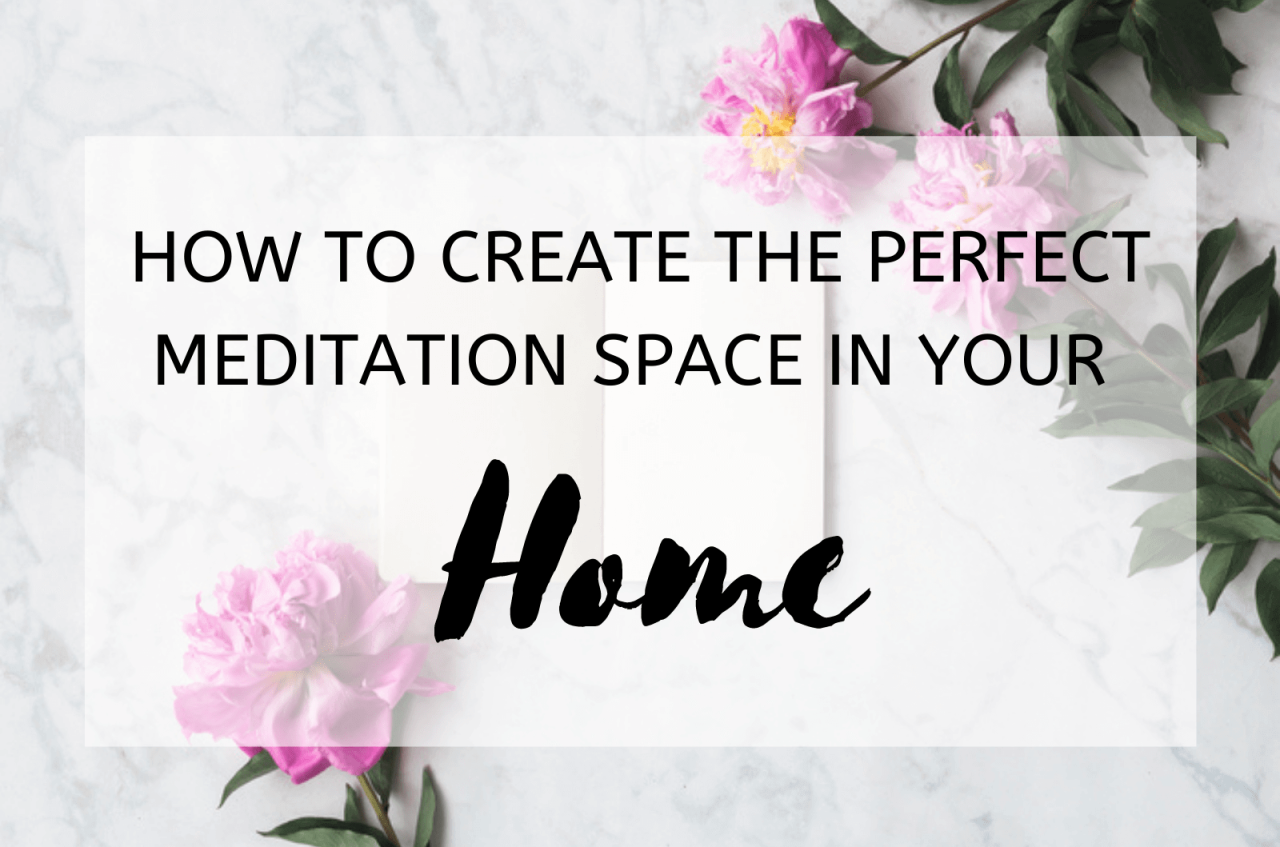Creating a dedicated meditation space at home can significantly enhance your practice. This guide provides a comprehensive approach to transforming a small corner or room into a tranquil sanctuary, fostering a sense of peace and focus. From defining the essential elements to personalizing the space, we’ll explore practical steps for creating an inviting and effective meditation environment, no matter your living situation.
This guide walks you through the process, from choosing the ideal location within your home to selecting the right furnishings and accessories. We’ll also explore how to create a calming atmosphere using color, texture, and natural elements, as well as how to maintain a peaceful environment over time. By the end, you’ll have a clear understanding of the key components required to cultivate a supportive meditation space tailored to your individual needs.
Defining the Meditation Space
A simple meditation space isn’t a lavish sanctuary, but a dedicated corner designed for quiet reflection and focused relaxation. Its primary purpose is to foster a calm and serene environment that encourages introspection and mindful presence. This space, while small, can significantly impact your overall well-being.A simple meditation space differs from a general relaxation area in its intentionality.
While a relaxation area might be used for various activities like reading or watching movies, a meditation space is specifically designed for focused introspection, eliminating distractions. The key is creating an atmosphere conducive to mindfulness.
Defining a “Simple” Meditation Space
A simple meditation space prioritizes core elements over elaborate design. It’s about creating an environment that promotes a sense of calm and peacefulness, not necessarily about aesthetics. The space should be free from visual and auditory distractions that could disrupt the meditative state. A well-defined meditation space fosters a sense of grounding and encourages a shift in mental focus.
Distinguishing from a Relaxation Area
A dedicated meditation space differs from a general relaxation area in its purpose and atmosphere. A relaxation area may feature soft lighting, comfortable seating, and calming colors, but it doesn’t necessarily promote the focused introspection necessary for meditation. The key distinction lies in the intention and the specific atmosphere designed to facilitate mindfulness.
Examples of Small Spaces
Transforming small spaces into effective meditation areas is achievable. A corner of a bedroom, a nook in a living room, or even a dedicated space under a stairway can all be transformed into peaceful sanctuaries. The crucial aspect is to minimize clutter and maximize serenity. For example, a small balcony or patio can be a serene retreat if furnished with comfortable seating and a few calming plants.
Creating a Tranquil Atmosphere
Simplicity in creating a tranquil atmosphere is key. Minimalist design, natural elements, and soothing colors are essential. Avoid overwhelming the space with too many items or patterns. Soft lighting, such as a warm-toned lamp, is more conducive to meditation than harsh overhead lighting. Incorporating natural elements like plants or a small water feature can enhance the calming ambiance.
The key is to focus on creating a sense of peace and stillness, rather than a decorative display.
Minimum Requirements for a Basic Meditation Space
This table Artikels the minimum requirements for a basic meditation space, emphasizing simplicity:
| Requirement | Description |
|---|---|
| Comfortable Seating | A cushion, chair, or mat that allows for a relaxed posture without discomfort. |
| Quiet Environment | Minimize distractions from noise or visual clutter. |
| Soft Lighting | Warm-toned lamps or diffused lighting. |
| Natural Elements | Plants, a small water feature, or natural textures can enhance calmness. |
| Minimal Clutter | Keep the space free from unnecessary items. |
Choosing a Location

Finding the right spot for your meditation space is crucial for a positive and productive practice. A well-chosen location can significantly enhance your experience, making it easier to focus and achieve a meditative state. Consider the environment’s impact on your ability to quiet the mind and connect with your inner self.Ideal locations should minimize distractions, offering a sense of tranquility and privacy.
Careful consideration of noise levels, lighting conditions, and personal preferences will contribute to a truly beneficial meditation environment.
Identifying Ideal Locations
A conducive meditation space should be free from disruptive sounds and visual stimuli. Noise from traffic, construction, or household activities can be highly distracting. Similarly, excessive or harsh lighting can make concentration challenging. Privacy is equally important, allowing you to feel undisturbed and at ease during your practice.
Comparing Locations Within a Home
Different areas of a house offer varying levels of suitability for a meditation space. Let’s examine some common locations and their potential advantages and disadvantages.
- Bedroom: A bedroom often provides a sense of seclusion, conducive to quiet reflection. However, if the bedroom is a hub of activity, it may not be the best option. The familiarity of the space can also sometimes make it harder to detach from daily thoughts.
- Living Room: A living room can be a suitable option if it can be made relatively quiet and private. The potential for interruptions from family members or guests might be higher, depending on the household dynamics. Creating a designated meditation area within the living room can help manage these distractions.
- Balcony or Patio: Outdoor spaces can be exceptionally tranquil, especially if they offer natural light and ventilation. However, outdoor spaces may be affected by weather conditions or noise from the surroundings.
- Study or Office: If you have a dedicated study or office, it can be a good choice, providing a sense of focus and privacy. Be mindful that the space might still be associated with work, potentially impacting your ability to detach.
Optimizing the Chosen Space
Once you’ve selected a location, optimizing it for minimizing distractions is key. This can involve simple steps, such as closing doors, turning off distracting electronic devices, or using soft furnishings to absorb noise.
Natural Light and Ventilation
Natural light and proper ventilation contribute significantly to a peaceful atmosphere. Sunlight can create a sense of calmness and connection to the outside world. Adequate ventilation helps maintain a fresh and invigorating environment, preventing stale air from affecting your mood. Proper air circulation can help minimize odors and promote relaxation.
Pros and Cons of Different Locations
The following table provides a concise comparison of different home locations for a meditation space, considering factors such as noise, light, and privacy.
| Location | Pros | Cons |
|---|---|---|
| Bedroom | Privacy, seclusion, familiarity | Potential for interruptions, association with sleep |
| Living Room | Flexibility, potential for designated space | Higher risk of interruptions, less privacy |
| Balcony/Patio | Natural light, fresh air, connection to nature | Weather dependence, potential noise from surroundings |
| Study/Office | Focus, privacy, dedicated space | Potential association with work, less relaxation |
Creating a Calming Atmosphere

Establishing a calming atmosphere is crucial for a productive meditation session. A serene environment encourages relaxation, allowing the mind to quiet and focus. This section details how to create such an atmosphere within your home meditation space.A well-designed meditation space transcends mere functionality; it becomes a sanctuary, a refuge from the outside world. By carefully selecting colors, textures, and incorporating natural elements, you can cultivate an ambiance that promotes a sense of peace and tranquility.
This will greatly enhance your meditation practice and overall well-being.
Soft Colors and Textures
Soft, muted colors like pastels, light blues, greens, and lavenders promote a sense of calm and serenity. Avoid harsh, bright colors that can stimulate the mind. Incorporating soft textures like plush rugs, cozy throws, and delicate fabrics further contributes to a relaxing environment. These tactile elements create a sense of comfort and invitatation, allowing you to fully immerse yourself in the meditative experience.
Consider using natural fiber materials like wool or linen, as these evoke a sense of warmth and connection to nature.
Natural Elements
Incorporating natural elements is paramount in creating a truly calming atmosphere. Plants, especially low-maintenance varieties, bring life and vibrancy to the space. The presence of natural light is beneficial; consider placing your meditation space near a window to allow natural light to filter in. Fresh air is also important; keeping the area well-ventilated will contribute to a sense of calm and clarity.
Adding a small water feature, such as a fountain or a bowl of water with smooth stones, can create a soothing sound that further enhances the meditative experience.
Reducing Distractions
Visual and auditory distractions can significantly impede the meditative process. Minimizing clutter and arranging items in a visually appealing and organized manner is essential. Keep the space free of unnecessary items that might draw attention. Soundproofing techniques, such as using rugs or curtains, can help dampen external noises. Consider using white noise machines or calming music to mask distracting sounds.
Prioritize a quiet and undisturbed environment to fully immerse yourself in the meditative state.
Calming Scents and Sounds
Aromatic diffusers and calming music can further enhance the meditative atmosphere. Essential oils, like lavender, chamomile, and sandalwood, are known for their relaxing properties. These scents can promote a sense of peace and well-being. Soft, instrumental music or nature sounds, like rain or flowing water, can create a calming auditory backdrop. These gentle sounds can help to drown out external distractions and immerse you in a state of deep relaxation.
Color, Texture, and Scent Considerations
| Color | Texture | Scent | Effect |
|---|---|---|---|
| Soft blues | Woven rugs | Lavender | Promotes tranquility and relaxation |
| Muted greens | Fluffy throws | Chamomile | Inspires peace and serenity |
| Light pinks | Silk pillows | Sandalwood | Encourages a sense of calm and focus |
| Creamy whites | Natural linen | Eucalyptus | Promotes clarity and focus |
Essential Items and Furnishings

Creating a tranquil meditation space extends beyond aesthetics; it encompasses practical elements that support a focused and comfortable practice. Essential items and thoughtfully chosen furnishings contribute significantly to the overall experience, fostering a conducive environment for introspection and relaxation. The right tools can enhance the effectiveness of your meditation sessions.
Essential Items for a Basic Meditation Setup
A basic meditation setup requires a few key items to support a comfortable and focused practice. These essential items, when combined with a calming atmosphere and a chosen location, create a holistic space conducive to meditation.
- Comfortable Seating: A comfortable seating option is paramount for a successful meditation session. A firm yet supportive surface allows the body to relax without strain, promoting a deeper connection with the mind. Avoid seating that encourages slouching or discomfort, as this can distract from the meditative process.
- Cushions or Pillows for Support: Cushions or pillows provide crucial support for maintaining a balanced and comfortable posture. This is particularly important for prolonged meditation sessions, where maintaining proper spinal alignment can aid in minimizing distractions and promoting deeper relaxation.
- Meditation Cushion (Zafu or Zabuton): These specialized cushions are specifically designed for meditation, offering excellent support for the hips and spine. Zafus are round cushions, while zabutons are rectangular cushions, both providing varying degrees of support and height.
Role of Comfortable Seating
A comfortable seating option is critical in establishing a conducive meditation space. Proper seating prevents discomfort and promotes relaxation, enabling the practitioner to focus on the meditative process without physical distractions. The chosen seating should support the spine in a natural, upright position without putting pressure on the body.
Significance of Cushions or Pillows
Incorporating cushions or pillows is crucial for a supportive and balanced posture during meditation. This support helps maintain a neutral spine and minimizes strain on the body, preventing discomfort and promoting relaxation. This in turn facilitates a deeper connection with the meditative state.
Different Types of Meditation Cushions and Their Benefits
Various types of meditation cushions cater to different preferences and needs.
- Zafu (Round Cushion): The zafu’s round shape and supportive nature promote a balanced seated posture, evenly distributing weight. This is particularly beneficial for those new to meditation or seeking a stable base for extended practice. The round shape often encourages a more grounded and centered feel.
- Zabuton (Rectangular Cushion): The zabuton, a rectangular cushion, provides a supportive base for the hips and legs. This is often used in conjunction with a zafu, offering a comfortable surface to sit on and facilitating an upright and stable posture.
Comparison of Different Seating Options for Meditation
Various seating options can be employed for meditation, each with its own set of advantages and disadvantages.
- Chairs: Standard chairs can be used, but may not provide the same level of support as specialized meditation cushions. The lack of adjustable height and support may lead to discomfort during extended sessions. However, for beginners, a chair can be an accessible and practical option.
- Meditation Benches: Meditation benches offer a stable and supportive seating alternative to chairs. These often feature adjustable heights and backs to accommodate varying needs. They provide a more supportive posture compared to chairs, particularly beneficial for longer meditation sessions.
- Floor Cushions: Floor cushions, such as zabutons, offer excellent support for the hips and legs. The soft and supportive nature of floor cushions promotes a relaxed and comfortable posture, crucial for a deep meditative state. They are also portable and adaptable to different meditation styles.
Essential Items Table
This table summarizes essential items for a basic meditation setup, along with their descriptions.
| Item | Description |
|---|---|
| Comfortable Seating | A supportive surface to maintain an upright posture during meditation, such as a chair, meditation bench, or floor cushions. |
| Meditation Cushion (Zafu or Zabuton) | A specialized cushion designed for meditation, offering support for the hips and spine. Zafus are round, and zabutons are rectangular. |
| Cushions/Pillows for Support | Additional cushions or pillows that provide extra support and comfort for maintaining a balanced and stable posture during meditation. |
Personalizing the Space
Transforming your meditation space into a sanctuary tailored to your unique preferences is key to fostering a deeper connection with your practice. A personalized space evokes a sense of calm and familiarity, making the meditation experience more inviting and conducive to focus. This personalization fosters a deeper connection with your practice, as a space that resonates with your personal style promotes relaxation and focus.Personalization goes beyond simply adding decorative items.
It’s about creating an environment that reflects your values, interests, and the specific type of meditation you practice. Careful selection of personal touches can significantly enhance the overall experience, making it more enjoyable and effective.
Reflecting Individual Preferences
Personalizing your meditation space involves incorporating elements that speak to your individual preferences. This includes choosing colors, textures, and styles that evoke feelings of peace and tranquility. Consider the colors you find soothing, the materials you find comforting, and the overall aesthetic that resonates with you. For example, a minimalist might choose clean lines and neutral tones, while a nature lover might opt for natural textures and earthy colors.
This careful selection fosters an environment that aligns with your personal style and preferences.
Incorporating Personal Items for Relaxation and Focus
Personal items play a crucial role in creating a personalized meditation space. Objects that hold sentimental value, evoke positive memories, or represent personal aspirations can be incorporated to enhance the space’s emotional connection. These items can act as anchors, grounding you in a feeling of comfort and security. For instance, a framed photograph of loved ones, a small piece of art that resonates with your soul, or a collection of crystals can add layers of meaning and purpose to your meditation.
Artwork, Plants, and Decorations for Aesthetic Appeal
Artwork, plants, and other decorations can elevate the aesthetic appeal of your meditation space. Art pieces that inspire calmness, such as landscapes, abstract paintings, or calming nature scenes, can set a serene mood. Plants, with their natural beauty and ability to purify the air, can add a touch of life and tranquility. Soft lighting, like a warm-toned lamp or a string of fairy lights, can further enhance the ambiance.
Consider incorporating a decorative bowl with smooth stones or a collection of meaningful figurines. These additions not only enhance the visual appeal but also contribute to the overall sense of peace and tranquility.
Personalization for Different Meditation Styles
The personalization of your meditation space can also be tailored to suit different meditation styles. Mindfulness meditation, for instance, might benefit from a minimalist design emphasizing clarity and simplicity. Guided meditation, conversely, could incorporate calming imagery and colors that enhance visualization. A space for loving-kindness meditation could feature symbolic elements that promote compassion and empathy. The specific style of meditation you practice should be reflected in the chosen decor and elements of the space.
Selecting Personal Items for a Peaceful Atmosphere
Careful selection of personal items is paramount to creating a truly peaceful atmosphere in your meditation space. Choose items that evoke positive emotions and feelings of tranquility. Consider the textures, colors, and patterns that resonate with you. These elements will subtly contribute to the space’s atmosphere and support a peaceful experience. Items should promote a sense of calm and promote a peaceful state of mind.
Think about the items that evoke feelings of comfort and peace in your life.
Table of Personal Items and Their Uses
| Personal Item | Description | How it Can Be Used |
|---|---|---|
| Framed Photograph | A picture of loved ones or a cherished memory | Place it on a shelf or table to evoke positive emotions. |
| Collection of Crystals | Small, meaningful crystals | Display them on a tray or in a decorative bowl to enhance energy and focus. |
| Figurines or Small Sculptures | Items with symbolic meaning or artistic value | Place them on a shelf or table to enhance visual appeal and meditation focus. |
| Natural Elements (stones, wood, plants) | Natural objects with calming textures | Incorporate them into the space for a grounding and serene atmosphere. |
| Calming Artwork | Paintings or prints that evoke serenity | Hang them on the wall to create a tranquil visual backdrop. |
Maintaining the Space
Maintaining a dedicated meditation space is not just about creating the environment; it’s also about consistently nurturing and preserving that tranquil atmosphere. Regular upkeep ensures the space remains a sanctuary for your practice, fostering a sense of peace and calm. This section will guide you through the steps to keep your meditation space clean, organized, and conducive to deep relaxation.Regular decluttering and tidying are essential for maintaining a serene meditation space.
A cluttered environment can easily distract and disrupt the focus needed for effective meditation. By keeping the space clear and uncluttered, you create a space that fosters tranquility and encourages introspection.
Maintaining Cleanliness and Organization
Maintaining a clean and organized meditation space is a vital aspect of cultivating a serene atmosphere. A clutter-free environment promotes a sense of calm and allows the mind to settle into a meditative state more readily. This includes not only physical cleanliness but also a sense of order and intentionality in the arrangement of items.
- Regular Cleaning: Dedicate a short period each day or week to wipe down surfaces, dust shelves, and vacuum or sweep the floor. This simple routine prevents the accumulation of dust and debris, which can affect the overall ambiance of the space.
- Decluttering Regularly: Schedule a more thorough decluttering session at least once a month. Review each item in the space, discarding anything you no longer need or use. This helps maintain a sense of clarity and purpose in the space, which positively impacts the meditation experience.
- Designated Storage: Ensure each item in the meditation space has a designated storage area. This prevents items from accumulating on surfaces, promoting a sense of order and organization. Using baskets, drawers, or shelves to store items helps to maintain a clean and clutter-free environment.
Importance of Regular Tidying
Regular tidying, in addition to regular cleaning, ensures a consistently positive and conducive atmosphere for meditation. This includes arranging items in a way that promotes peace and harmony, not just keeping the space clean.
- Visual Appeal: Arrange items aesthetically pleasingly. Ensure the space looks inviting and harmonious, not cluttered or overwhelming. This subtle attention to detail enhances the sense of peace and calm.
- Meaningful Items: Only include items that have significance or meaning to you. Removing items that no longer resonate with your practice helps keep the space focused on its purpose.
- Minimalism: Consider practicing minimalism in the space. Limit the number of items to only those essential for meditation. This reduces visual distractions and fosters a more focused and peaceful atmosphere.
Maintaining a Serene Atmosphere
A serene atmosphere is key to successful meditation. Maintaining this atmosphere over time involves ongoing attention and care. The space should consistently evoke feelings of tranquility and peace.
- Air Quality: Ensure good air quality by using an air purifier or keeping the space well-ventilated. Fresh air contributes to a more comfortable and pleasant environment.
- Ambient Lighting: Maintain soft, calming lighting, perhaps using candles or a Himalayan salt lamp. Adjust lighting as needed to match the time of day and the desired ambiance.
- Natural Elements: If possible, incorporate natural elements like plants or a water feature. These elements can further enhance the sense of calm and serenity in the space.
Step-by-Step Guide for Maintaining the Space
Following these steps helps ensure your meditation space remains a sanctuary of peace and tranquility.
- Weekly Check-in: Set aside 15-20 minutes each week to thoroughly check the space. This includes cleaning surfaces, tidying up items, and ensuring the atmosphere remains serene.
- Monthly Deep Clean: Dedicate a few hours once a month for a deep clean and declutter. Assess all items, discard unnecessary ones, and reorganize the space.
- Seasonal Refresh: At the beginning of each season, refresh the space. This might involve changing the décor, rearranging items, or introducing new elements. The goal is to keep the space fresh and vibrant while maintaining its serene atmosphere.
Last Word

In conclusion, this guide provides a structured approach to designing a simple yet effective meditation space at home. By focusing on key elements like location, atmosphere, and essential items, you can cultivate a serene and inspiring environment conducive to relaxation and focused practice. Remember, a well-designed meditation space is an investment in your well-being, allowing you to deepen your connection with yourself and create a consistent practice.